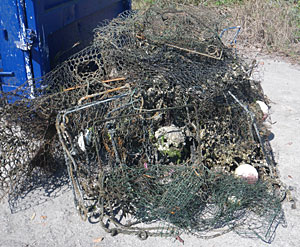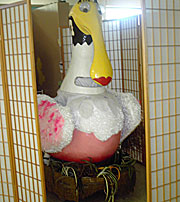 |
||||||||
Marine Debris: Local Solutions to a Global Problem
By Matthew Cimitile


Photo by Matthew Cimitile
Volunteers unload derelict crab traps from an air boat after a February cleanup in Tampa Bay.
Litter has always been an issue in Florida – as witnessed by the middens created by prehistoric Indians on coastal sites across the state. Accumulated over hundreds or perhaps even thousands of years, oyster and clam shells rise as high as 20 feet and often become the base for temples and burial sites.
But as more people move to the coasts and the use of inorganic materials like plastics increases, debris becomes a much more significant problem in the marine environment. Billions of pounds of trash find their way to the ocean yearly from both land and marine sources. On land, litter like plastic bags, cigarette butts and food wrappers easily moves through storm drains and streams that eventually lead to larger bodies of water. On boats, fishing lines are cut when they tangle in mangroves or snag on the seafloor, nets are discarded when no longer needed, and damaged crab traps are abandoned.
The amount of marine debris that has accumulated world-wide is staggering: patches as large as Texas circulate in desolate areas of the Pacific and Atlantic oceans. Trash washes ashore constantly on remote island sanctuaries like Midway Atoll, 1200 miles away from the nearest large city in Hawaii.
Marine life, including seabirds and turtles, may confuse the plastic in the water for food. Recent studies on albatrosses that nest at Midway found traces of plastic in 99% of albatross chicks. The U.S. Fish and Wildlife Service estimates that adult albatrosses bring back five tons of plastic to feed their chicks. Ingestion of plastic probably plays a part in the large number of chicks that die of dehydration and starvation each year.
In Florida, scientists have identified discarded monofilament fishing line as the top killer of adult brown pelicans. Hundreds and possibly thousands of other birds, including endangered species that nest in Tampa Bay, die after they are tangled in monofilament line.
Other local impacts from marine debris include:
- Monofilament, plastic bags and six-pack rings can ensnare and tangle fish and other marine life, including sea turtles and manatees.
- Plastics do degrade in water, but very slowly, morphing into microplastic particles that remain in the environment for long stretches of time. Scientists are concerned that microscopic pieces of plastic will be consumed by creatures at the bottom of the food web and eventually concentrate in larger organisms.
- Car batteries and other hazardous waste dumped in waterways degrade water quality and may endanger environmental and human health.
Although it's impossible to determine how much debris exists or how much new litter enters the system each year, data from cleanup efforts provide a glimpse of the marine debris footprint. Since 1989, Tampa Bay Beautification (formerly known as the Mayor's Beautification Program) has removed 1.2 million pounds of debris and invasive plants, with 110,000 pounds removed in 2010 alone, said Raina O'Neil, development director of the program. At just Fort De Soto and Cunningham Key last year, Tampa Bay Watch removed 9,200 pounds.
"Volunteers can't believe how many tons of garbage they remove in just four hours," said O'Neil. "It is really surprising what we find too. Besides the normal cigarette butts, plastic bags and bottles, we have pulled many car batteries out of the Hillsborough River."
One reason for the large volume of marine debris in the area is the number of people who live here. Another is the ample opportunity created with multiple connections between tributaries, streams, rivers and the bay.
"In Pinellas County, anything that's left outside in a heavy rain probably ends up in a storm drain," said Bill Sanders, executive director of Keep Pinellas Beautiful. "And then if we don't capture it first, it ends up in the bay or the gulf."
Innovative Local Solutions
If marine debris and its impacts are a global problem, local communities that spearhead cleanup efforts and debris prevention are the solution. One innovative solution is Tampa Bay Watch's derelict crab trap removal program held several times during the year during extreme low tide events.
Crab traps pose particular hazards because they continue to catch and eventually kill crabs and other marine life long after they have been abandoned. "We call it ghost fishing," said Serra Herndon, habitat restoration director for Tampa Bay Watch.
"No one is checking on the traps, nobody is releasing the crabs, no one is taking the crabs. The traps are just sitting there trapping marine life without any way for it to escape."
To remove derelict traps, Tampa Bay Watch teams up with airboat captains from the Florida Airboat Association and the U.S. Geological Survey to navigate the shallow waters where many traps are found. One morning in February, five airboats with two to three volunteers each hauled in about 50 damaged or abandoned derelict traps.
"During our removals of these derelict traps we commonly find mullet, snook, lots of toad fish and very, very occasionally we'll find terrapins which are a brackish water turtle," Herndon said. "The terrapin population has been decimated in Tampa Bay and one of the reasons is that they get trapped in the derelict traps and can't get out. Removing the traps helps us save these poor little critters and it also cleans up marine debris."
Community cleanup efforts are scheduled by local groups practically year round in the bay area. In addition to neighborhood and coastal clean-ups, environmental groups often organize events at wildlife sanctuaries, including monofilament clean-ups in mangroves and other bird habitat.
A key to reducing marine debris is catching litter before it escapes into the bay or gulf. In Pinellas, volunteers focus on bayous that connect to the bay. They also have identified events that are likely to cause problems. "Fort DeSoto is totally trashed on the Fourth of July, so we always schedule a clean-up the first Saturday after that," Sanders said.
At the University of South Florida in St. Petersburg, the Student Environmental Awareness Society has installed debris booms around storm water runoff drains in downtown St. Petersburg. Called 'watergoats,' the booms can stretch up to 75 feet to capture a large amount of debris. The first one installed last year caught over 2,250 pounds of trash at Bayboro Harbor. Another has been installed at the Brooker Creek outfall using mini-grant funds from the Tampa Bay Estuary Program.
Reaching Out to Volunteers, Kids

Photo courtesy Keep Pinellas Beautiful
Rosie, the roseate spoonbill mascot of Keep Pinellas Beautiful grew from a costumed figure to a fully functional robot who can respond to questions, nod her head and flap her wings. She visits schools across the county.
Cleanup efforts not only reduce marine debris, but also educate volunteers about the impact of litter. "One of the advantages that I see is that it educates our constituents that this is not just a local problem," said Martha Gruber, an environmental scientist with Tampa Bay Watch. "Marine debris is an international problem, so picking up trash on our shoreline stops that debris from going elsewhere."
According to O'Neil, cleanup efforts translate into educational opportunities with a positive long-term impact. "Just in the Hillsborough River alone, we would easily remove 15 tons of garbage in one day during River Cleanup events in the 1990s. Now it is down to four or five tons. I think people are starting to have a better understanding of the watershed and the interconnectedness of the environment as a whole."
Organizations on all sides of the bay have active outreach programs targeted at youngsters. The KPB mascot grew from a costumed roseate spoonbill to a six-foot robot who can talk and flap her wings. In Hillsborough, Marina DeBris and Pete the Pelican Pirate are regular visitors in schools. Manatee Beautiful, a costumed critter with a lily pad hat, encourages children to protect her habitat.
Scientists and environmentalists hope that continued outreach and education will supply the long-term solution to the marine debris problem in Tampa Bay and globally -- prevention. And preventing marine debris largely rests on the old adage: reduce, reuse, recycle.
"Any talk of solutions to the marine debris problem will begin with reevaluating how we are going about our daily lives," said Nicholas Mallos, a marine scientist with the Ocean Conservancy. "Consumers, businesses and governments all have vital roles to play in preventing marine debris. Many businesses and corporations today are using more recycled and reusable materials because of consumer choices in what and where they buy. Some businesses have pledged only to use recycled and renewable resources by a certain date. And through policy, governments can encourage such behavior to continue."
Marine debris is a global issue with severe consequences to fisheries, marine life, coastal environments and human communities that depend upon healthy ecosystem functions for jobs, recreation and health. The solution will come from cleanup efforts and educational initiatives that lead to healthier water bodies in Tampa Bay and around the world.
Matthew Cimitile is a writer working for the U.S. Geological Survey Coastal and Marine Science Center in St. Petersburg and a frequent contributor to Bay Soundings.
You can help!
March to May are the big months for clean-ups in the Tampa Bay area and you can join a group to help out almost any weekend. If you miss the Spring events, mark your calendar early for the Sept. 17 International Coastal Cleanup sponsored by the Ocean Conservancy.
Here are some highlights:
April 16, Great American Cleanup events in Hillsborough, Pasco and Manatee counties, Recycle Regatta at St. Petersburg's North Shore Park
April 23, Earth Day events across the region
May 28, Spoil island clean-up in Pinellas County
Check these sites for updated information:
In Hillsborough County, www.khcbonline.org or www.tampabaybeautification.org
In Manatee County, www.manateebeautiful.com
In Pinellas, www.pinvol.org
In Pasco, www.keeppascobeautiful.org
